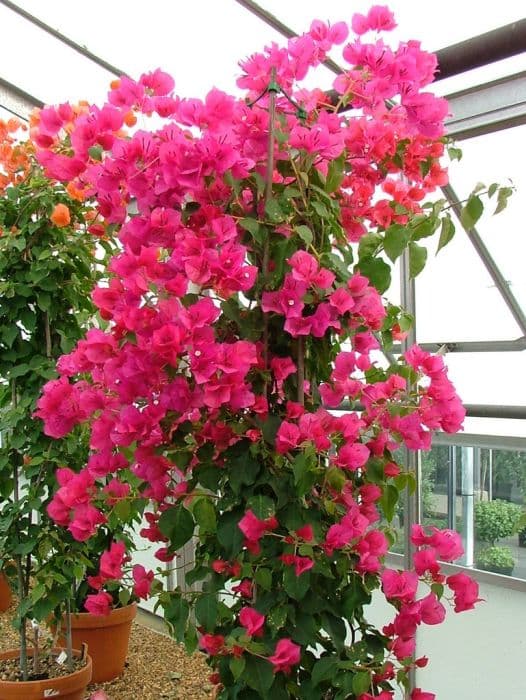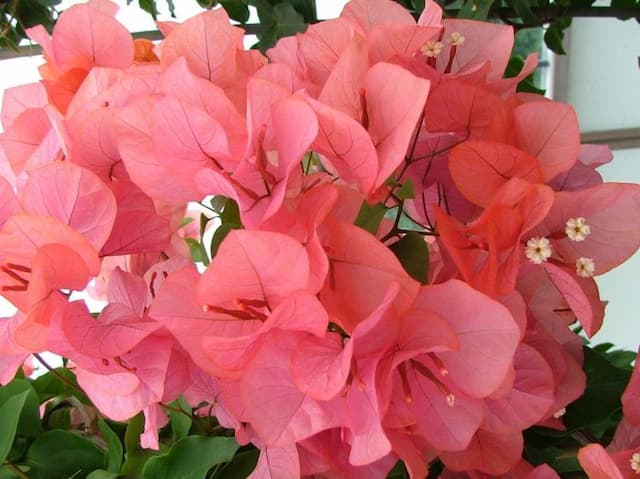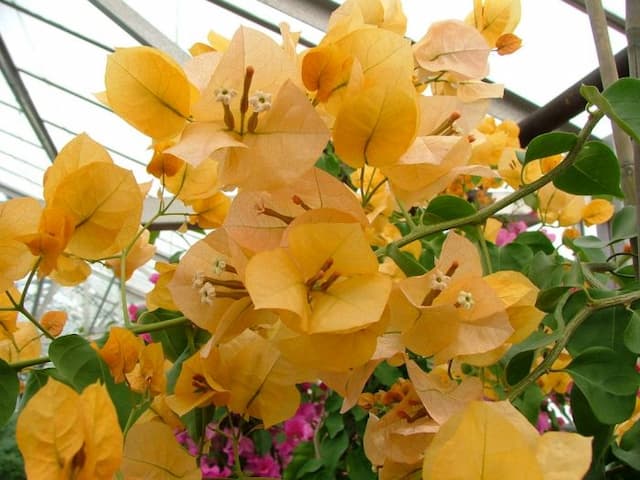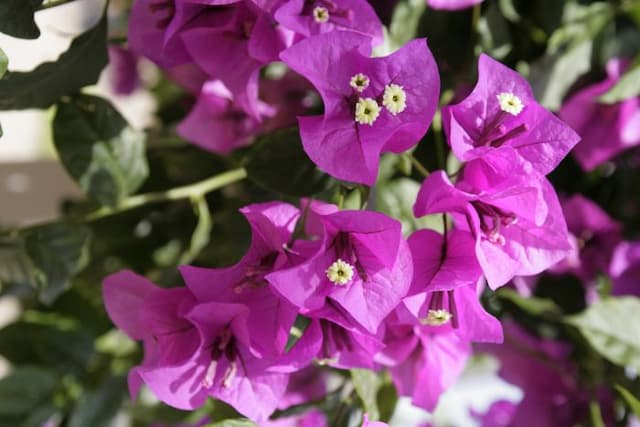Bougainvillea × buttiana 'Mrs Butt'

ABOUT
The Bougainvillea 'Mrs Butt' is a vibrant and lush plant that is widely cherished for its stunning floral display. It presents a riotous explosion of color, most typically characterized by its vivid magenta or purple-pink paper-like structures, often referred to as bracts, that surround the small, inconspicuous true flowers within. These striking bracts are what primarily give the 'Mrs Butt' its aesthetic appeal and flamboyant show of color that can easily draw attention in any landscape or garden setting. The foliage of the plant consists of green leaves that provide a beautiful contrast against the intense color of the bracts. The leaves are generally broad, somewhat oval in shape, and have a pointed tip, giving the plant a dense, lush appearance. The combination of the bright bracts and verdant foliage allows for a dynamic and tropical feel. Along with its flora, 'Mrs Butt' tend to grow in a sprawl of intertwining branches that can attach themselves to surfaces with thorns. With a cascade of iridescent colors and an abundance of foliage, 'Mrs Butt' brings life and exuberance wherever it is planted, sans the specific details of its dimensions.
About this plant
 Names
NamesFamily
Nyctaginaceae
Synonyms
Paper Flower, Lesser Bougainvillea
Common names
Bougainvillea × buttiana 'Mrs Butt'.
 Toxicity
ToxicityTo humans
Bougainvillea is not considered highly toxic to humans. If ingested, some people may experience mild irritation of the mouth, vomiting, or diarrhea. These symptoms are typically not severe. However, it is always prudent to avoid ingestion of plants that are not meant for consumption.
To pets
Bougainvillea is also not highly toxic to pets. If a pet ingests parts of the plant, they might experience similar symptoms as humans, such as mild gastrointestinal upset, including vomiting or diarrhea. While generally not life-threatening, pet owners should still discourage their animals from eating ornamental plants and should consult a veterinarian if significant symptoms arise.
 Characteristics
CharacteristicsLife cycle
Perennials
Foliage type
Evergreen
Color of leaves
Green
Flower color
Varies
Height
15-40 feet (4.5-12 meters)
Spread
5-15 feet (1.5-4.5 meters)
Plant type
Climber
Hardiness zones
9
Native area
South America
Benefits
 General Benefits
General Benefits- Colorful Display: Bougainvillea 'Mrs Butt' provides vibrant blooms in a range of colors, adding aesthetic appeal to gardens and landscapes.
- Drought Tolerance: Once established, it's highly tolerant to drought, making it suitable for regions with water scarcity.
- Heat Resistance: The plant thrives in hot climates, making it ideal for warm-weather gardens.
- Low Maintenance: Requires minimal care beyond initial training and occasional pruning, thus saving time and effort.
- Privacy Screen: When trained on trellises or fences, bougainvillea serves as an effective natural barrier and privacy screen.
- Pest Resistance: Generally resistant to most pests, reducing the need for chemical interventions.
- Soil Adaptability: Bougainvillea can adapt to a variety of soil types, although it prefers well-draining soil.
- Seasonal Interest: Offers year-round interest in milder climates, with peak blooming in spring and summer.
- Urban Tolerance: Capable of surviving in urban conditions, which can be harsher than rural environments.
- Wildlife Attraction: Attracts pollinators such as bees, butterflies, and hummingbirds, which are beneficial for the ecosystem.
- Versatility: Suitable for growing in containers, making it an option for those with limited space or no garden.
 Medical Properties
Medical PropertiesThis plant is not used for medical purposes.
 Air-purifying Qualities
Air-purifying QualitiesThis plant is not specifically known for air purifying qualities.
 Other Uses
Other Uses- Bougainvillea can be used as a natural dye. The bracts of the plant contain pigments that can be used to dye fabrics and even food items.
- It serves as a barrier plant. Because of its thorns, it is often planted beneath windows or along boundaries as a security measure to deter intruders.
- The plant is used in bonsai cultivation. Its woody stems and ability to bloom almost all year round make it a popular choice for the art of bonsai.
- Bougainvillea can be used in the creation of living fences or hedges. With proper training and pruning, the plants can form dense barriers that can define property lines or create private spaces.
- Culinary presentation. The colorful bracts of the Bougainvillea can be used to enhance the presentation of dishes in high-end restaurants, although they are not edible.
- It's utilized in landscape artistry to create 'living walls'. The fast growth and lush foliage of Bougainvillea are used to cover vertical structures, providing a vibrant tapestry of color.
- The wood of older Bougainvillea can be crafted into small implements or decorative items. Though not commonly used this way, the wood can be carved or turned into unique pieces of art.
- As a photographic subject or backdrop. Bougainvillea's vivid colors make it a favorite among photographers and event planners when they want to create a striking natural scene.
- Education and research. The plant is used in botanical studies to teach about growth patterns, pruning techniques, and color variation in plants.
- Ink production. Similar to natural dying, the pigments found in the bracts can be used to make inks for art or writing.
Interesting Facts
 Feng Shui
Feng ShuiThe Bougainvillea is not used in Feng Shui practice.
 Zodiac Sign Compitability
Zodiac Sign CompitabilityThe Bougainvillea is not used in astrology practice.
 Plant Symbolism
Plant Symbolism- Passion: Bougainvilleas are often associated with intense passion due to their vivid and vibrant flower-like bracts.
- Beauty: The plant's striking appearance symbolizes beauty, reminding us that beauty can be found in harsh conditions, as bougainvilleas are known for their resilience.
- Resilience: The ability of the bougainvillea to thrive in poor soils and withstand drought reflects the symbolic meaning of resilience and overcoming hardship.
- Warmth: The hearty growth and warm colors of the bougainvillea embody a sense of welcoming and warmth, often associated with the hospitality of the regions where it flourishes.
 Water
WaterThe Bougainvillea, commonly known as Paper Flower, requires watering when the top inch of soil becomes dry, typically every 3-5 days during active growth periods and less frequently during cooler months. Water the plant thoroughly until excess water drains out of the bottom of the pot, which may equal roughly 1-2 gallons depending on the size of the plant and pot. It's important not to overwater a Paper Flower as it prefers drier conditions. In hot summer weather, watering may need to be increased to account for higher evaporation rates.
 Light
LightPaper Flower prefers full sun conditions and should be placed in a spot where it gets at least 6 hours of direct sunlight daily. An ideal location would be a south-facing garden or a sunny patio. Ensuring adequate light will promote vibrant blooms and healthy growth.
 Temperature
TemperaturePaper Flower thrives in warmer temperatures, with ideal growing conditions ranging from 65 to 75 degrees Fahrenheit. It can survive minimum temperatures of around 40 degrees Fahrenheit, but frost can be detrimental. The plant should be protected from cold drafts and frost, and if potted, brought indoors or covered during cold snaps.
 Pruning
PruningPruning Paper Flower is essential to control its growth and to promote thicker, more floriferous branching. The best time to prune is in late winter or early spring, just before the onset of the growth season. Prune several inches off the tips of the stems, and remove any dead or diseased wood. Pruning can be done every year or as needed to maintain the desired shape and size.
 Cleaning
CleaningAs needed
 Soil
SoilBougainvilleas prefer a well-draining soil mix with organic matter such as peat or pine bark. A mixture of two parts loam, one part sand or perlite, and one part organic material is ideal for bougainvilleas. Ensure the pH level is slightly acidic to neutral, around 5.5 to 6.5. Proper drainage is critical to avoid root rot.
 Repotting
RepottingBougainvilleas should be repotted every two to three years or when they become root-bound. Larger specimens can be repotted less frequently. Prune the roots gently if they are excessively long during repotting to encourage new growth and a compact root system.
 Humidity & Misting
Humidity & MistingBougainvilleas thrive best in average to high humidity levels but are quite adaptable and can tolerate a range of conditions. For optimal growth and blooming, aim for a relative humidity level between 40% and 60%.
 Suitable locations
Suitable locationsIndoor
Place in bright sunlight; water when soil is dry.
Outdoor
Full sun, well-drained soil, protect below freezing.
Hardiness zone
9-11 USDA
 Life cycle
Life cycleThe Bougainvillea 'Mrs Butt' starts its life as a seed, which germinates in warm soil with adequate moisture. The seedling phase follows, where cotyledons emerge, followed by true leaves as it establishes roots and begins photosynthesis. Growth and vegetative development continue, with the plant producing long, vine-like branches that may require support or pruning. During the flowering stage, which can be year-round in optimal conditions, it displays vibrant bracts that surround the small, true flowers, attracting pollinators. After pollination, the plant may produce small, dry fruit containing seeds, although propagation is often achieved through cuttings. The bougainvillea may enter a dormancy phase in cooler climates or during the dry season, only to return to active growth and flowering with the return of favorable conditions.
 Propogation
PropogationPropogation time
Spring to Summer
The most popular method of propagation for Bougainvillea × buttiana 'Mrs Butt', commonly referred to as Bougainvillea, is through semi-hardwood cuttings. Typically, the best time to take cuttings for propagation is late spring to early summer. To propagate, a cutting of about 4 to 6 inches (10 to 15 centimeters) long is taken from a healthy parent plant. The cutting should have several sets of leaves. The bottom set of leaves is removed, and any flowers or buds should also be pruned off to redirect the cutting's energy into root development. The cut end of the cutting can be dipped in rooting hormone to enhance root growth, though it's not strictly necessary. The cutting is then planted in a well-draining soil mix and kept moist until roots have established, which typically takes a few weeks.
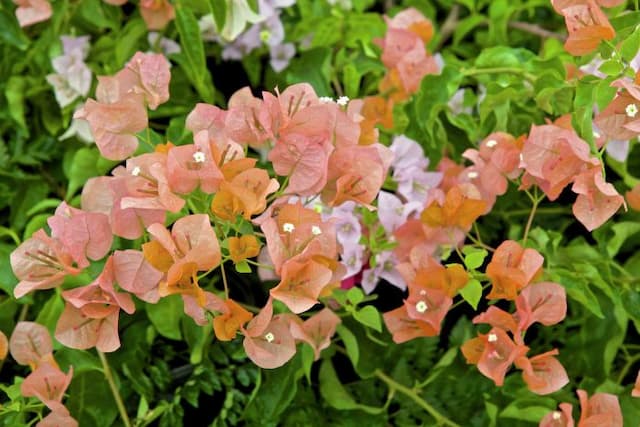
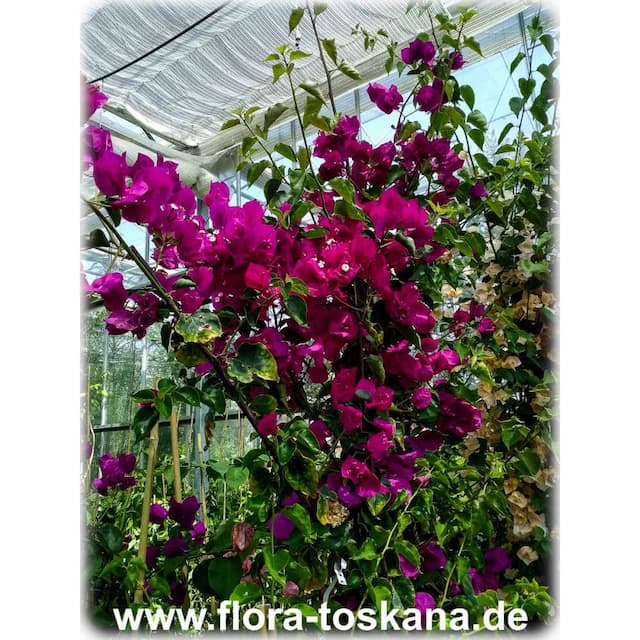
![Bougainvillea [Texas Dawn]](/_next/image?url=https%3A%2F%2Fplants-admin.emdemapps.com%2Fimages%2Fplants%2F%2Fimages%2F604b5f2598081.png&w=640&q=75)
